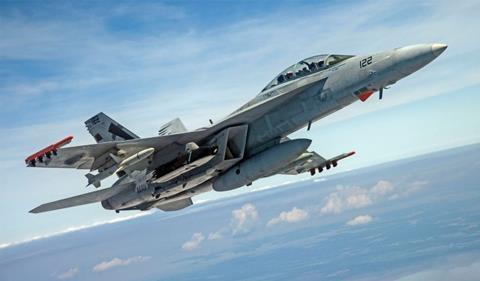Military airframer and munitions producer Lockheed Martin continues to advance the company’s stealthy Long-Range Anti-Ship Missile (LRASM), recently test firing four of the ship-killing weapons simultaneously.
Lockheed on 3 April announced it had supported the US Navy (USN) during the LRASM’s 12th integrated test event, which saw four of the cruise missiles fired at once, a flight profile Lockheed describes as “historic”.
The LRASM can be air-launched or fired from naval surface ships and ground-based systems.
While Lockheed does not reveal specifics about the test, such as which aircraft type launched the LRASMs, the company says all mission objectives were met.
“The US Navy was able to demonstrate the weapon’s inherent high-end lethality from mission planning through kill chain integration and its effects on the target,” Lockheed says.

The first LRASM was delivered to the USN in 2018, with low-rate production ongoing since then. The ship-killing cruise missile is expected to be one of the most important weapons for the USA, should conflict ignite in the Western Pacific.
In 2022, war games conducted by the US-based Center for Strategic and International Studies (CSIS) found an adequate supply of LRASMs would be essential to defending Taiwan against invasion by China, which could feature hundreds of enemy surface ships in the waters surrounding the disputed island.
According to the USN, LRASM uses semi-autonomous guidance algorithms to identify and pinpoint targets from “less precise” coordinate data. This in turn reduces the service’s dependency on intelligence, surveillance and reconnaissance platforms, communications network links and GPS-based navigation when conducting strikes.
“When operational, LRASM will provide the first increment of a next-generation offensive anti-surface weapon,” the US Naval Air Systems Command says. “[It] will play a significant role in ensuring military access to operate in open ocean and the littorals due to its enhanced ability to discriminate and conduct tactical engagements from extended ranges.”

During the CSIS Taiwan scenario war games, evaluators found long-range bombers, including Boeing B-52s and Boeing B-1Bs, proved particularly effective when armed with LRASM.
Currently, the US Air Force’s (USAF’s) Boeing B-1B heavy bomber is certificated to deploy LRASMs, as are navy Boeing F/A-18E/F Super Hornet strike fighters.
Lockheed has also been pursuing type approval with its own multi-service F-35 stealth fighter and the Boeing P-8 maritime patrol aircraft.
The USAF had at one point been pursuing LRASM certification for its B-52 heavy bombers, but Lockheed in 2023 said that effort was no longer underway.
The company assembles both the LRASM and the Joint Air-to-Surface Standoff Missile in Troy, Alabama. In 2022, Lockheed completed work on a second production line in Troy, boosting capacity for the two weapon systems.
Lockheed has said it aims to eventually deliver more than 1,000 missiles annually.
“We have continued to invest in the design and development of LRASM’s anti-surface warfare capabilities,” says Lisbeth Vogelpohl, LRASM programme director at Lockheed’s Missiles and Fire Control division.
The USN’s fiscal year 2025 budget documents, which describe LRASM as the most urgently needed anti-ship weapon system, indicate the service plans to continue developing the next iteration of the missile – known as LRASM C-3 – that boasts extend range, advanced survivability and beyond line of sight communications.































